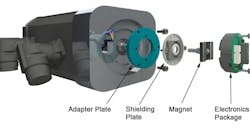What’s Inside the Optimized Full Performance Kit Encoder from Posital?
POSITAL’s new “kit” encoders provide a new alternative for manufacturers who need closed-loop feedback to control rotary position of servomotors or stepper motors, or to provide commutation for brushless motors. They are designed to hit an optimal performance between low-cost, low-performance resolvers and high-precision, high-price optical encoders.
These devices are based on the company’s magnetic rotary encoders. The difference is that the core components are available as separate assemblies that can be easily integrated into other products. Key components include:
- A permanent magnet array, designed to be mounted on the motor’s shaft
- An electronics package, assembled on a single 36 mm diameter printed circuit board
- A magnetic shield that isolates the magnetic pickups in the electronics package from external magnetic fields (such as from a magnetic brake in the motor)
The electronics package at the heart of the new kit encoder includes four Hall-effect magnetic sensors that measure the position of the rotating magnet array. A 32-bit microcontroller runs advanced signal processing software that collects and filters the output of the Hall-effect sensors and computes the angular displacement of the rotating magnet. The measurement resolution is 17-bit resolution, while accuracy is better than + 0.1°. The signal processing algorithms have been optimized to reduce latency and provide good dynamic response to sudden changes in rotation. A built-in rotation counter that is powered by POSITAL’s Wiegand-effect energy harvesting technology provides multi-turn measurement capabilities.
Because the system is self-powered, rotation counts are always accurate, even if the rotations occur when external power is unavailable. There is no need for backup batteries or geared optical disks. This makes the encoders both rugged and low-maintenance. The operating temperature range is −40 to +105 °C. Communications interfaces for the devices are based on open-source communications protocols—including BISS, SSI, and RS485-based protocols—eliminating reliance on proprietary communications systems and controllers.
POSITAL magnetic kit encoders are easy to incorporate into normal manufacturing processes since they do not require the high-precision, clean-room assembly techniques demanded by optical technologies. A built-in self-calibration capability can be used to compensate for small sensor-to-shaft alignment errors that occur during the assembly procedure.


